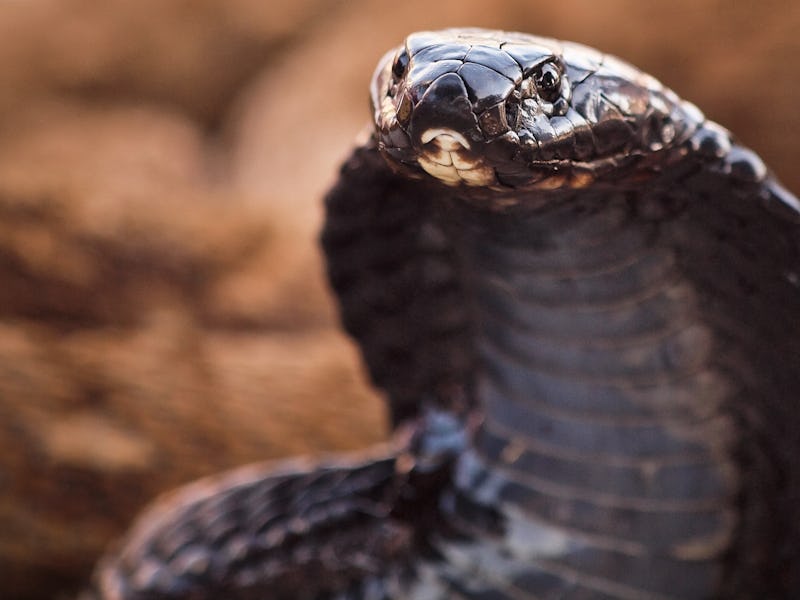New Weapon Against Gruesome Venomous Snakebites Is Invisible to the Eye
Time is tissue, but this treatment might stop the clock.

When it comes to venomous snake bites, time is tissue. Even non-fatal snake bites still rapidly kill skin and muscle in a gruesome process called necrosis, often leaving victims permanently disfigured. In an effort to help reduce the global health burden of these bites, a team of scientists has developed an antivenom cocktail that saves tissue after a snake bite, sparing survivors a lifetime of disability.
In a paper published Thursday in the journal PLOS Neglected Tropical Diseases, researchers demonstrate that their formula, when injected into mice that had been exposed to venom from a black-necked spitting cobra (Naja nigricollis), protected against any tissue-killing effects. What’s unique about their new treatment is that it’s not made up of any one substance but a mixture of nanoparticles, which can target the individual compounds that make up a snake’s poison.
“If this is achieved, then the progression of this local necrosis would be halted, and then the person can be transported to a health facility to receive the antivenom, but the local tissue damage would have been controlled and the frequency of permanent tissue damage and sequelae would be reduced,” José María Gutiérrez, Ph.D.. a senior professor of microbiology at Instituto Clodomiro Picado (the University of Costa Rica) and one of the paper’s authors, tells Inverse.
The venom from the black-necked spitting cobra (Naja nigricollis) quickly begins killing skin and muscle tissue at the site of a bite, which can cause long-term disability.
One of the major challenges in dealing with venomous snake bites is that no one snake venom is the same.
“Most people think of venoms as a poison” — that is, a single poison — “and they’re not. They’re very complex mixtures of a variety of complex compounds,” Steve Mackessy, Ph.D., a professor of biological sciences at the University of Northern Colorado who was not involved in the new study but who extensively studies venomous snakes, previously told Inverse. Therefore, every snake antivenom must be custom-tailored to the species it’s meant to protect against. Sometimes venom varies so widely that populations of the same species of snake living in different regions require different antivenoms. This is exactly the problem that Gutiérrez and his co-authors hope to address.
Their formula, made of synthetic polymer nanoparticles that bind to the various venom proteins and isolate them from the body’s tissues, was developed in the lab of Kenneth Shea, Ph.D., a distinguished professor of chemical biology at the University of California, Irvine, where most of the study was performed. It has the potential to be developed into an easy-to-use frontline treatment for venomous snake bites. When injected directly into the site of the bite, the nanoparticles would block necrosis, helping to stabilize victims until they can receive the appropriate antivenom from a medical facility.
Though the formulation is tailored specifically to the black-necked spitting cobra, the nanoparticles within it can also bind toxins in venoms from other snakes in the Elapidae family, such as the highly dangerous kraits, cobras, and mambas.
“It is foreseen that, in the future, the treatment of snakebite envenomings may be based in the combination of antivenom administration in hospitals and the application of inhibitors (such as these nanoparticles) in the field rapidly after the bite,” says Gutiérrez. “This would prevent the development of these pathological effects. But more research in various fronts is required to reach this goal.”
It will take further animal and human testing to bring a product like this to market, but Gutiérrez and his team are encouraged by their initial results in mice. Public health officials are waking up to the global burden of venomous snake bites, including the lifelong problems they can cause for victims.
Many of these injuries occur in rural regions of developing countries, where healthcare is hard to access and record-keeping isn’t always comprehensive. For these reasons, the World Health Organization has designated snake envenomation a category A Neglected Tropical Disease. And while numbers for snake venom-induced disabilities are hard to nail down, researchers estimate that 400,000 people are maimed by non-fatal snake envenomation each year — in addition to the estimated 100,000 people who die each year from their encounters with venomous snakes.
If scientists can develop a frontline treatment to help slow the clock until patients can get to hospitals, it’s conceivable that the world will see fewer lives affected by snakebite-related disabilities. This process will take a number of years, but Gutiérrez plans to keep soldiering on.
“The results obtained so far are highly encouraging and promise to represent a new approach to abrogate the toxicity of snake venoms.”